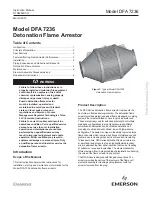
Bends in piping, pipe expansions and/or contractions,
valves orifice plates or flow obstructing devices of any kind
cause turbulent flow. Turbulent flow enhances mixing of the
combustible gases, greatly increasing the combustion intensity.
This can result in increased flame speeds, higher flame
temperatures and higher flame front pressures than would
occur in normal flow conditions. Obstructions in protected side
piping can cause pressure buildup that might inhibit the effective
performance of the DFA Series under certain conditions.
Installation
WARNING
!
Always make sure that the system is at
atmospheric pressure and that there is no
ignitable gas that could flash when either
installing or maintaining the unit.
Lifting
DFA Series arrestors are not designed for single point lifting. An
appropriately designed spreader bar must be used when lifting
or moving the unit. The angle of the lift lines should be no more
than 5° from the vertical (refer to Figure 4). Recommended
shackles are Crosby 1-3/4" 25t-G-2130 (Stock No. 1019659)
or equivalent.
Connection
DFA Series arrestors are normally provided with CL150
raised or flat faced flanges. Other flanges such as CL300
are sometimes provided on special request. Make sure the
companion flanges installed in adjacent piping match the
flanges on the detonation flame arrestor.
Standard compressed fiber gaskets that withstands
temperatures of 450°F / 232°C or higher are normally used,
but other materials of equal or higher temperature capability
may be used at the customer’s discretion.
Positioning
CAUTION
The detonation flame arrestor element
is fitted with lugs for lifting the element
assembly during servicing operations. These
lugs are not intended for lifting the entire
unit. Damage to the detonation flame arrestor
may result from improper lifting. The unit
should be lifted using the lugs located on
each end-section or with appropriately rated
Nylon (PA) straps rigged on the outside
of the tension studs. Detonation flame
arrestors fitted with temperature sensors
are directional dependent if the temperature
sensor is only installed on one side of the
arrestor. The sensor must be located on the
unprotected side of the arrestor in that case.
The arrestor should be positioned such that the entire
arrestor is accessible for removal. Install the unit such that
the flow arrow located on the unit points in the direction
travelling with the vapor flow. Models that have drain
plugs are designed for horizontal installation and should
be installed with the drain ports aligned at the bottom of
the unit. Models that have pressure taps are designed to
allow pressure gauges to be installed on both sides of the
flame cell assembly to determine blockage. The pressure
taps should be aligned at the top to allow easy viewing of
the gauges. Units that are equipped with optional internal
cleaning systems should be connected to a source of
cleaning media such as water, steam or other suitable
solvent. Observe recommended installation practice as
detailed bends and/or flow obstruction section.
Flow Direction
The DFA Series is not bi-directional when temperature
sensors are installed unless a sensor is installed on both
sides of the arrestor element assembly. All arrestors covered
in this manual can be installed either vertically or horizontally.
Consideration should be given to non-symmetrical assemblies
that include features such as clean-out ports, temperature
monitoring device or other options that might have a preferred
installation direction to suit the needs of the customer.
Piping Expansions and Reductions
Adjacent to Detonation Flame Arrestor
WARNING
!
No instrument, tubing or other device
whatsoever shall circumvent the detonation
flame arrestor in such a manner to allow a
flame path to exist around the flame element
of the arrestor. When instrumentation is
installed in such a manner that it creates
a path circumventing the flame element
of an arrestor, measures must be taken
to prevent passage of flame through the
instrumentation device and/or system.
Instrumentation must be capable of
withstanding the maximum and minimum
pressures and temperatures to which the
device may be exposed and at a minimum
be capable of withstanding a hydrostatic
pressure test of 350 psig / 24 bar.
DFA Series detonation flame arrestors may be installed in
any vapor control line that is smaller than or equal to the
nominal pipe diameter of the arrestor’s connection flanges.
When it is necessary to increase the diameter of the piping
on the downstream side (unprotected) of the detonation
flame arrestor, a length of pipe at least 120 pipe diameters
must be installed between the detonation flame arrestor
and the expansion. A pipe diameter is considered as the
inside diameter of pipe having a nominal size equal to the
detonation flame arrestor’s connecting flanges.
4
Model DFA 7236
North America
Only


























